How To Clean Computer So It Runs Faster
For many Windows users like you, when their computer runs slowly, the first thing they do is to clean up their computer. Cleaning up computer is easy and quick. If you also want to clean up your slow computer, just use one of the methods below (for Windows).
Summary:
Can cleaning up make computer run faster?
3 methods to clean up a slow computer
What to do if your computer is still slow
Can cleaning up make computer run faster?
Cleaning up means cleaning up your computer hard drive. If your computer slow down because of too much data stored on your computer hard drive, cleaning up will work.
The hard drive is your computer's memory storage facility. It stores your operating system, files and applications. When you launch an application or open one of your files, the CPU (Central Processing Unit) will fetch the application or the file from the hard drive, then transfer them to RAM (Random Access Memory).
If you have too much data stored on the hard drive, it'll take longer for your CPU to find the application or the file you need. This can slow down your computer. In this situation, cleaning up some applications and files can make your computer run faster.
3 methods to clean up a slow computer
We've put together 3 methods below for you to clean up your slow computer. You may not need to try all of them; just work your way down until you find the one that works for you.
Method 1: Perform a disk cleanup
Method 2: Uninstall unwanted apps
Method 3: Defragment your hard drive
Method 1: Perform a disk cleanup
To clean up your slow computer, you can perform a disk cleanup. Disk Cleanup is a built-in Windows utility which allows you to clean the temporary files, recycle bin files, the system files, etc.
You can refer to these steps to perform a disk cleanup:
1) Type "disk cleanup" in the search bar and select Disk Cleanup from the list. Then the Disk Cleanup dialog box will pop up.
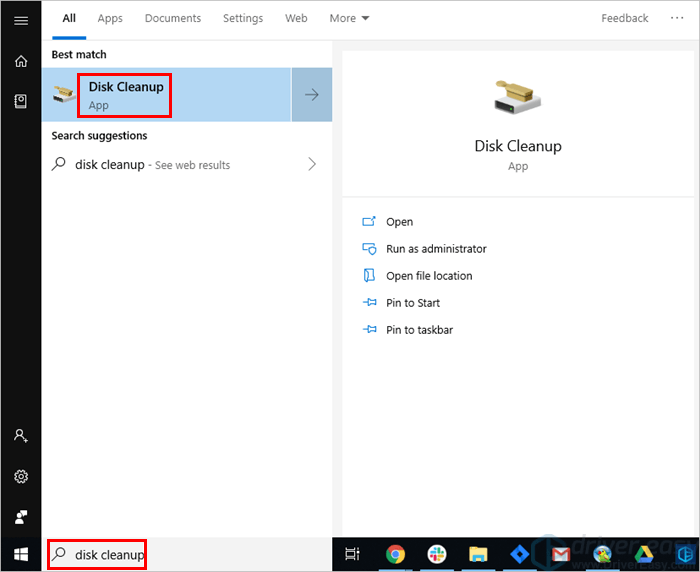
2) Click Clean up system files.
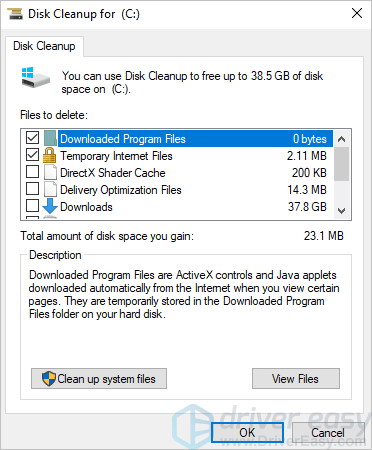
3) Select the hard drive you wish to clean up and click OK.
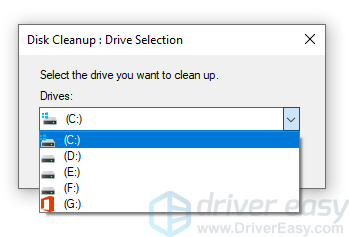
4) Under Files to delete, select the file types you want to delete, for example, the Temporary files.
If you can't tell what the file type means from the name, you can get the description by selecting the file type.
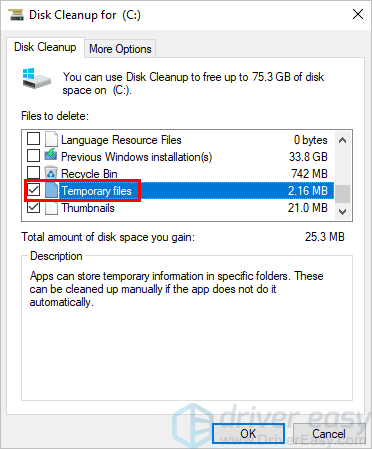
5) Click OK.
6) Repeat the above steps to clean up all the drives you want to clean up.
7) Check to see if your computer is still slow.
Method 2: Uninstall unwanted apps
Apps can take up storage space of the hard drive. You may have installed some apps, but you've never used them. For these apps, you can just delete them to free up the space.
You can refer to these steps to uninstall an application:
1) Go to Control Panel.
2) View by Small icons and select Programs and Features.

3) Select the app you want to uninstall and click Uninstall (For some apps, this could be Uninstall/Change). If you're not sure which app you can uninstall, sort the apps by Size from largest to smallest, then select the apps you can uninstall.
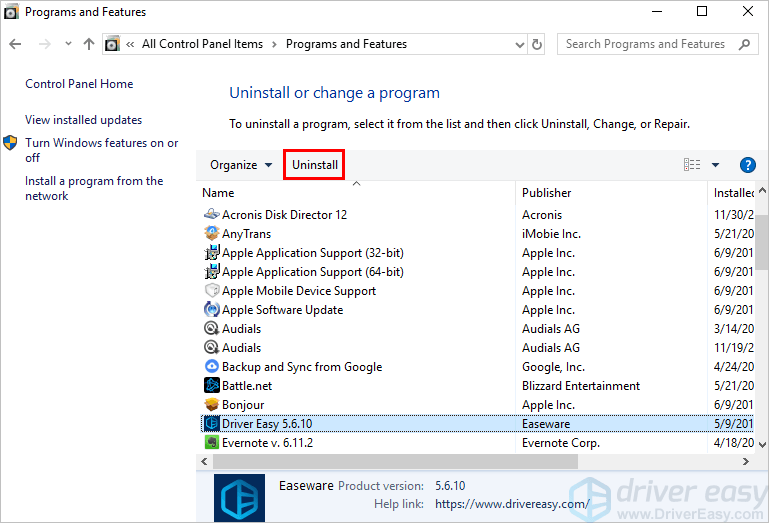
4) If you're prompted to confirm the change, select Yes to allow the change.
5) Repeat the above steps to uninstall the apps you can uninstall.
6) Restart your computer and check to see if it's still slow.
Method 3: Defragment your hard drive
Not all files are written into the hard drive as a whole thing. They can be divided into lots of small fragments. This can happen when some places of the hard drive are not large enough to store a single whole file. For these files, it will take longer for the drive head to read them. This can cause your computer to slow down.
So the last method you can try is to defragment your hard drive. Defragging is another type of cleanup. It is a process that reduces the amount of fragmentation in file system. It puts all divided data of the file together so the drive head can read the data fast. This can speed up your computer.
Here's how to defragment your hard drive:
1) Type "defragment" in the search box, and select Defragment and Optimize Drives from the list.
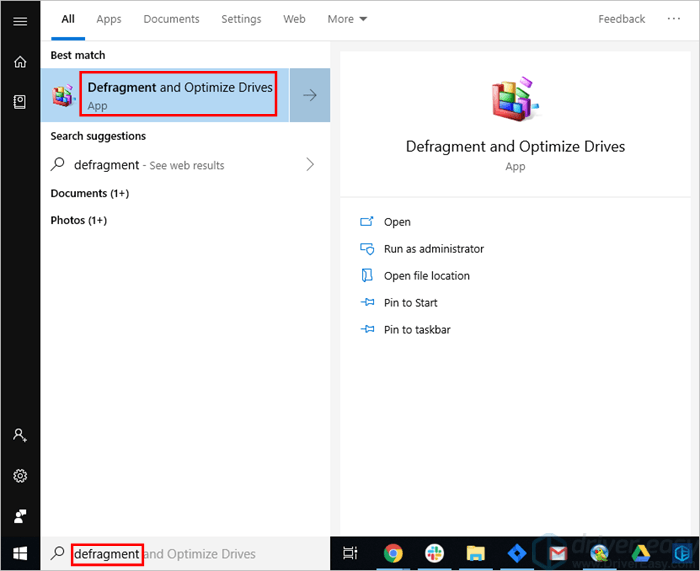
2) Under Status, select the drive you want to defragment, and then click
Click Optimize. To determine if the drive needs to be optimized, click Analyze.
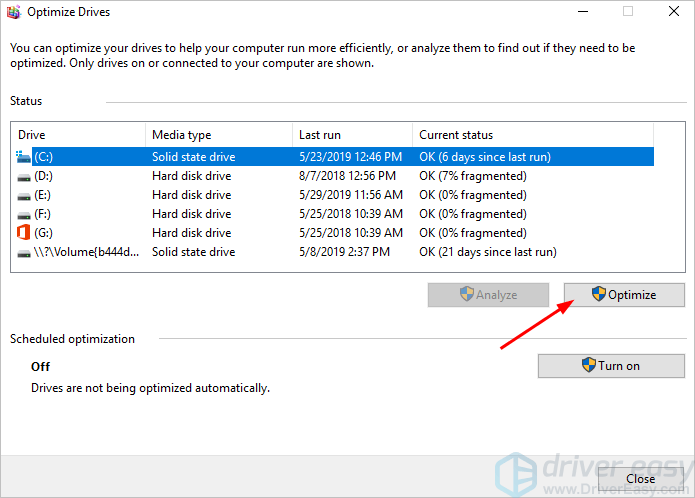
3) Repeat the above steps to defragment all drives you want to defragments.
What to do if your computer is still slow
The above three methods should fix your computer slow issue. But if your computer is still slow, you can try the following methods.
Close unnecessary apps
Your computer speed depends on the size of the RAM. If you have multiple apps running at once, your RAM may not be able to handle them all at once. Then your computer can run slowly.
So if you have multiple apps running at once, close the apps as much as you can. If you know what apps you're running, just close them as usual. For the apps running in the background, you may not notice them. Then you need to close them via Task Manager.
Here's how to close an app via Task Manager:
1) Type "task manager" in the search box then select Task Manager from the list.
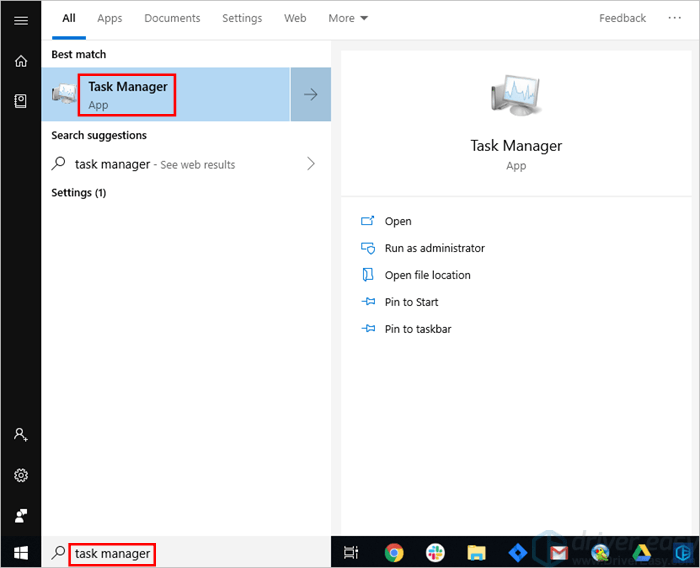
2) Under the Process tab, select the app you don't need it currently.
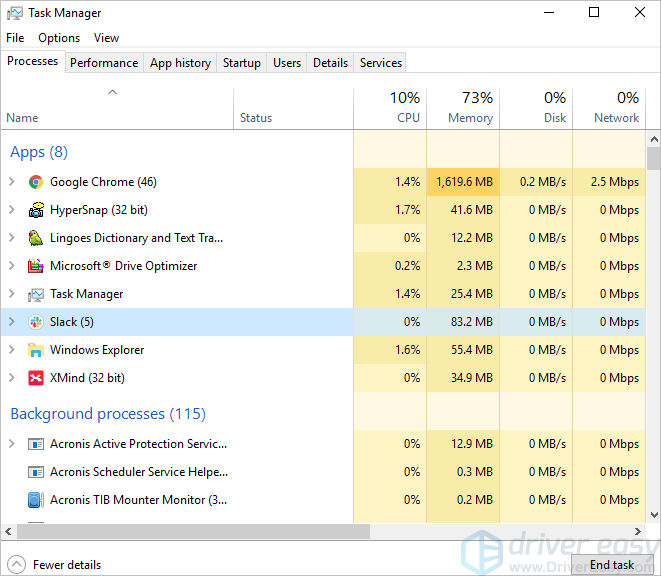
3) Click End task.
4) Repeat the above steps to close other apps you don't need.
5) Restart your computer and check to see if your computer is still slow.
Disable startup apps
Some apps automatically launch when Windows boots. This can make your computer boot longer. If you don't close them while you're using the computer, your computer can run slowly. So to make your computer run faster, you can disable the startup apps via Task Manager.
To do so , you can follow these steps:
1) Type "task manager" in the search box then select Task Manager from the list.
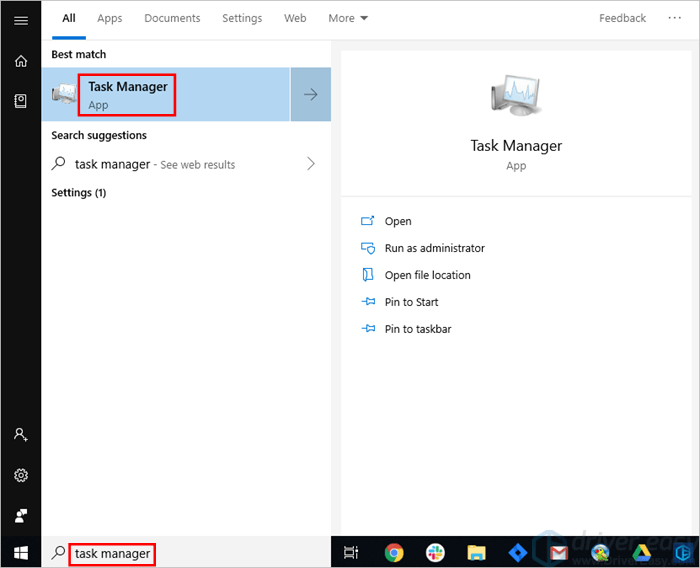
2) Select the Startup tab, then select the app you don't need it to run at startup.
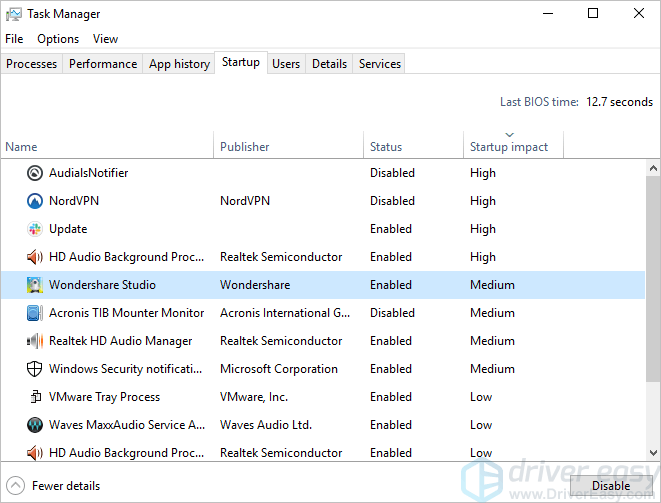
3) Click Disable.
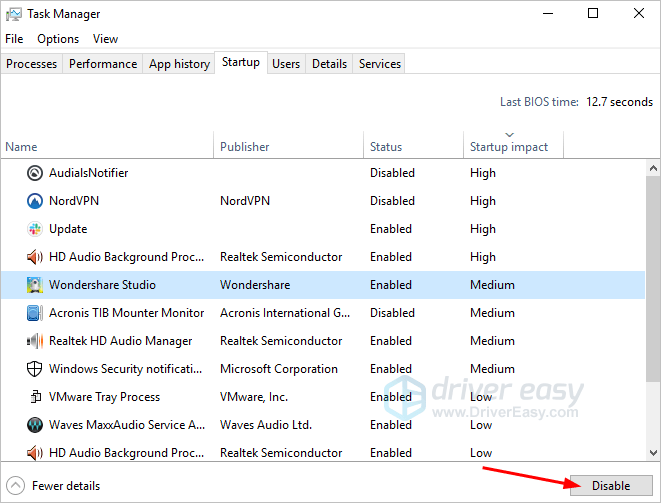
4) Repeat the above steps to disable other apps you don't need them to run at startup.
5) Restart your computer and check to see if your computer is still slow.
Check for virus
If your computer has a virus, it probably runs slowly. So check if your computer has a virus. If it has a virus, you need to remove the virus as soon as possible.
The best way to remove the virus is using an antivirus software. If you already have installed an antivirus software on your computer, use it to scan your computer to detect the virus. If you don't have installed an antivirus software, install one.
If you're not sure what antivirus software is the best, we recommend you use Avast Free Antivirus.
Avast Free Antivirus is an antivirus software with 400 million users around the world. So you can trust it. With an easy-to-use interface, it allows you to remove virus easily and quickly.
Just download and install it on your computer. Then launch it to scan your computer to detect virus.
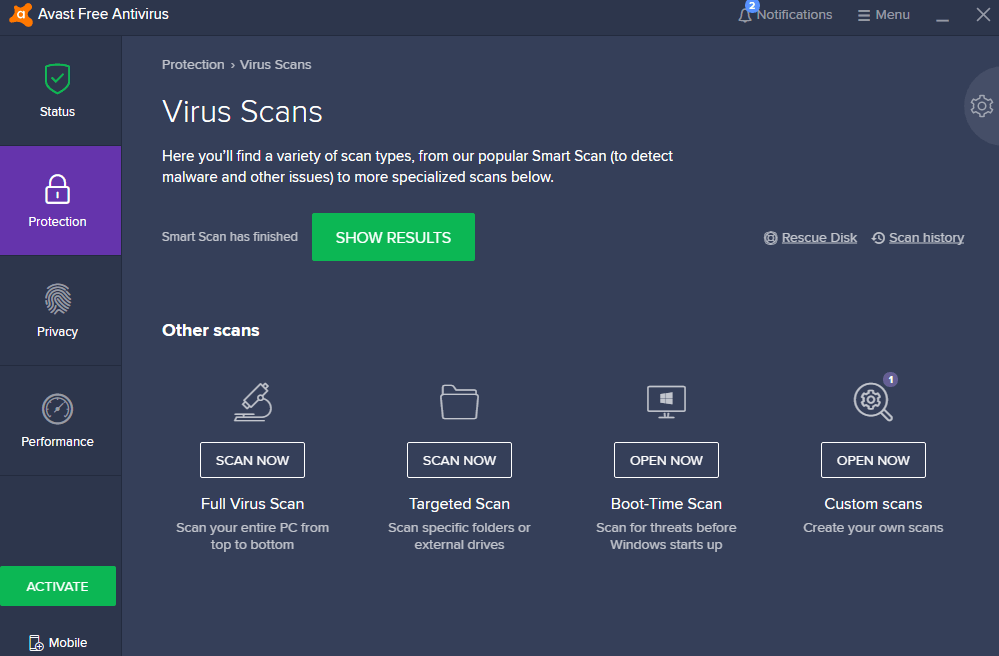
Hopefully you find this article helpful. If you have any questions, ideas or suggestions, feel free to leave a comment below.
How To Clean Computer So It Runs Faster
Source: https://www.drivereasy.com/knowledge/how-to-clean-up-your-slow-computer-step-by-step/
Posted by: nelsondroutich.blogspot.com

0 Response to "How To Clean Computer So It Runs Faster"
Post a Comment